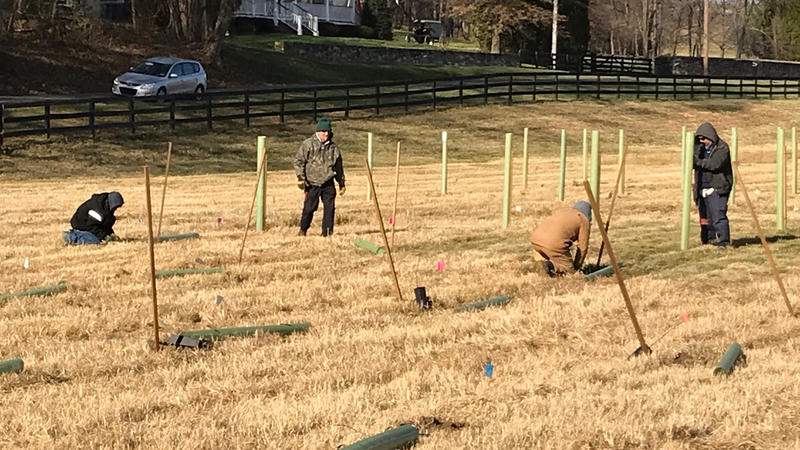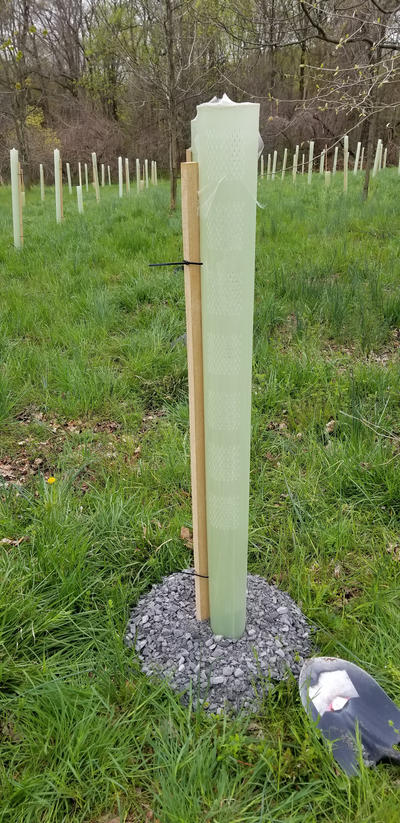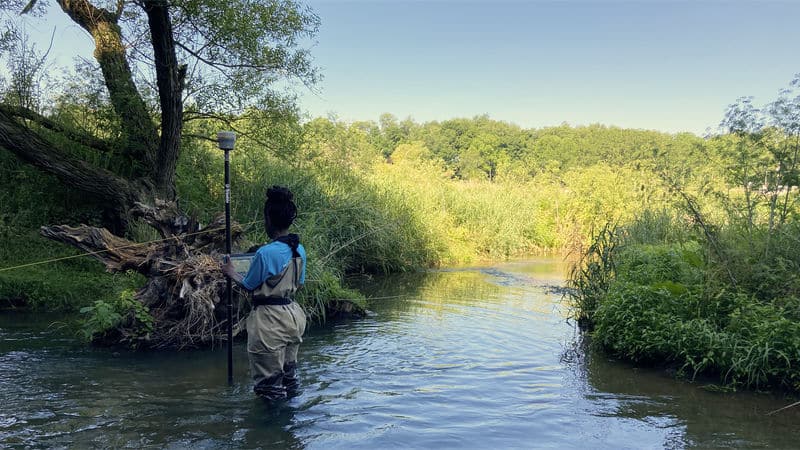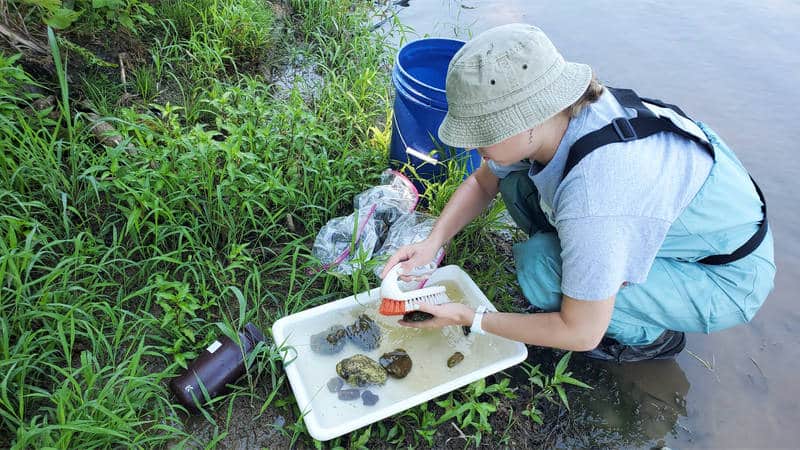An Update on Research Seeks to Reduce Plastic Waste, Maintenance Costs, and the Mortality of Planted Trees and Shrubs

Wasteful spending, pollution, and the restoration of healthy streams have something in common: poorly executed tree plantings. Around the world, billions of dollars are spent on tree plantings to combat climate change, improve water and air quality, and provide a variety of environmental and human health benefits. However, a focus on planting rates rather than survival rates has meant many (often most) of those trees and dollars have been wasted.
Understanding the crucial role of streamside forests in protecting waterways and the clean fresh water that feeds them, Stroud Water Research Center scientists sought to reforest a portion of its research stream, White Clay Creek, beginning in 1989. At the time, the tree survival rate was only 20%.
In response to those depressing odds, Bern Sweeney, Ph.D., former director and distinguished research scientist emeritus, began researching methods to improve the growth and survival of planted trees. His experiments and others have yielded a fourfold increase in tree survival and a doubling of tree growth. Best practices based on this research are now part of the guidelines for multiple U.S. Department of Agriculture programs that offer financial incentives for environmental enhancements.

Current Methods That Increase Tree Survival and Growth
The Stroud Center has made important discoveries about tree survival and growth by field testing a variety of planting and maintenance practices. Questions answered include:

- How to prevent weeds from competing with tree seedlings.
- How herbicide and stone mulch can protect against damage caused by rodents, with stone mulch being a cost-effective option.
- How tree shelters can protect against damage to planted trees caused by deer and increase tree growth.
- How different types of tree shelters affect tree survival and growth.
- When and if to remove tree shelters.
- How to control weeds, grasses, and vines inside tree shelters.
While this research has improved the odds of successful reforestation significantly, challenges remain and are the subject of a new study.
New Research to Reduce Waste From Forest Plantings
On 18 acres surrounding Octoraro Creek in southeastern Pennsylvania, the Stroud Center’s Robin L. Vannote Watershed Restoration Program has planted trees and is researching ways to reduce waste — from tree loss to maintenance costs to plastic pollution from discarded tree shelters.
The site provides a unique opportunity. It’s uncommonly large with relatively uniform conditions, allowing the team to field test a variety of practices on the same site. It also comes with some common challenges facing those who attempt to plant trees: deer and reed canary grass.
In 2022, the team began a four-year project to reduce waste from forest plantings.
| Research | Early Insights (Year 2 of 4) |
|---|---|
| Preliminary results will require additional testing (both more years and more sites), but initial findings are that the prototype appears effective in plots mowed at least twice a year. | Mowing is likely still necessary, but frequency may be reduced. |
| Test at least three brands of biodegradable tree shelters for their ability to break down after use. | One brand has been tested and found to lose structural integrity too soon. |
| Test methods for preventing trees from flopping over due to top growth exceeding stem strength. | TBD |
| Test a new approach to managing rodent damage that could reduce the likelihood of trees flopping over and eliminate the need for plastic bird nets: Instead of using shelters that create a physical barrier, use ones with a large open base to expose rodents to predators and allow birds to escape. | A small shelter inside any protection method is beneficial, and maintenance inside those sheltering methods is highly beneficial. Five-foot tubes work as well as a sheltering instrument, but they might cause the shrubs to grow leggy before filling out. An 18-inch tall shelter improves success when added to deer-browse barriers, such as individual cages or welded wire fencing around groups of shrubs. |
| Test options in flood-prone areas, such as (1) fiberglass (vs. wooden) stakes to support tree shelters and (2) larger planting stock without staking or tree shelters. | Without a shelter to prevent damage by deer, larger stock did not offer any advantage. To date, flooding on the sites has not shown any significant difference based on the type of stake used to support tree shelters. |
| Determine if a one-time herbicide application before using stone mulch can help prevent reed canary grass from outcompeting newly planted trees. | Pre-spraying with herbicide does not appear to add value. |
| Test several methods to increase the survival of ecologically important multistem species, such as dogwood and arrowwood viburnum, which have been difficult to grow. | A small shelter inside any protection method is beneficial, and maintenance inside of those sheltering methods is highly beneficial. Five-foot tubes work as well as a sheltering instrument, but they might cause the shrubs to grow leggy before filling out. An 18-inch tall shelter improves success when added to deer-browse barriers, such as individual cages or welded wire fencing around groups of shrubs. |
In addition to the restoration research on best practices, Stroud Center principal investigators Melinda Daniels, Ph.D., and Marc Peipoch, Ph.D., collected baseline stream data on site. They hope to acquire funding to study the long-term impact of the new 18 acres of forest on the health of Octoraro Creek.


This work would not be possible without the support of generous donors and landowners, including Carol E. Ware, Ph.D. The Stroud Center is grateful to the people who help us excel in our mission to advance knowledge and stewardship of fresh water.
What You Can Do
- To learn how you can increase tree survival and growth on your property, check out these watershed restoration resources.
- Please donate today to support research, education, and restoration that protects clean fresh water.
This article was originally published on February 15, 2023, and updated on December 4, 2024.



